Fascism is a radical authoritarian nationalist political ideology. Fascism has several defining characteristics, but a few of the most prominent that will be covered here are:
Militarism: Fascism promotes political violence and war as actions that create national regeneration, spirit and vitality [1]. Violence is often seen as being necessary for progress.
Nationalism: The fascist view of a nation is of a single organic entity which binds people together by their ancestry and is a natural unifying force of people [2]. It often manifests in a desire to purify the nation of foreign influences that are causing ‘degeneration’ or which don’t fit into the national culture – this sometimes results in extreme xenophobia or racism as seen in Nazi Germany.
Unity/Social Solidarity: Fascism supports a socially united, collective national society and opposes socially divided class-based societies and socially-divided individualist-based society.
Authoritarianism (Sometimes Totalitarianism) and Personality Cultism: “The Fascist conception of the State is all-embracing; outside of it no human or spiritual values can exist, much less have value. Thus understood, Fascism is totalitarian, and the Fascist State—a synthesis and a unit inclusive of all values—interprets, develops, and potentiates the whole life of a people” [3]. Authoritarianism is a form of social organization characterized by submission to authority. A cult of personality arises when an individual uses mass media, propaganda, or other methods, to create an idealized and heroic public image, often through unquestioning flattery and praise [4]. Cults of personality are typically associated with dictatorships.
Fascism peaked in popularity in Europe in the 20s and 30. Three of the most significant examples are Italian Fascism (under Benito Mussolini), German Nazism (under Adolf Hitler), and Spanish Falangism (under Francisco Franco).
All three of these groups made extensive use of both text and visual propaganda. Due to several of fascism’s core tenets (such as nationalism, authoritarianism, and unity) any fascist regime has an incredibly high need for propaganda; both so it may rise as the dominant ideology, and to promote public cohesion.

In Spain, the Spanish Civil War (1936-1939) broke out when the Spanish army in Morocco, led by General Francisco Franco, rose up against the democratically elected Republican government. “Essentially, the ranks of the Left (also known as Loyalist and Republican) comprised workers, peasants and trade unions, but also the Spanish government, Socialists, Communists and Anarchists. The Right (also known as Nationalist), was supported by rebellious factions of the army, industry, landowners, the middle classes and the Catholic Church” [5]. For various reasons, the Left was backed by the Soviet Union and various European democracies, and the Right received extensive military backing and funding from fascist regimes such as Germany and Italy. All of the various factions in Spain vied to have their views known and popular. The Left as a whole was particularly susceptible to rampant in-fighting between the factions. Not unlike most other civil wars that have occurred in the world, extensive propaganda was produced on all sides, by all factions, both supporting their own cause while denouncing others’. After much bloodshed, the Nationalists were finally triumphant. The Spanish Civil War would be a revolutionary one, and General Franco’s victory marked the beginning of a forty-year dictatorship in Spain (1939-1975). All groups that supported the Nationalists were “absorbed into a single party under his [Franco’s] control, The Falange Espanola Tradicionalista y de las JONS. […] The area of propaganda was placed in the hands of the Falange” [6]. The Spanish Civil War is often cited as a “dress rehearsal” for WWII which would occur shortly after.
In Germany, the German Empire was dissolved in the German Revolution of 1918–19, and a democratic government, later known as the Weimar Republic, was created. With the onset of the Great Depression in the late 20s, domestic support for the Nazis (German National Socialists) rose and, in 1933, Hitler was appointed Chancellor of Germany. In the aftermath of the Reichstag fire, Hitler created a totalitarian single-party state led by the Nazis. Nazism, is the common short form name of and was the ideology and practice of the Nazi Party and of Nazi Germany. It is a unique ideology of composed of both fascism and a strong biological racism and antisemitism. They considered Jews a parasitic race that attached itself to various ideologies and movements to secure its self-preservation, such as capitalism, democracy, the Enlightenment, industrialisation, liberalism, Marxism, parliamentary politics, and trade unionism [7]. Nazis sought to exterminate or impose exclusionary segregation upon “degenerate” and “asocial” groups that included: Jews, homosexuals, Romani, blacks, the physically and mentally disabled, Jehovah’s Witnesses and political opponents [8]. Some of the Nazi’s most notable characteristics are: “Building on a charismatic leader figure [Personality Cultism] (Adolf Hitler) and on the support of the military, inventing common enemies, trying to re-model the working class by making the workers focus on ‘higher ideals’ than the traditional class struggle; such ‘higher ideals’ included extreme nationalism, racism, and especially war. […] Finally, an [it is an] aggressively nationalistic ideology that puts the nation over the individual, and demands that the nation be extended to its “natural” territorial borders.” [9]. The NDSAP used propaganda aggressively and proudly. Hitler himself in Mein Kampf writes:
Propaganda must always address itself to the broad masses of the people. (…) All propaganda must be presented in a popular form and must fix its intellectual level so as not to be above the heads of the least intellectual of those to whom it is directed. (…) The art of propaganda consists precisely in being able to awaken the imagination of the public through an appeal to their feelings, in finding the appropriate psychological form that will arrest the attention and appeal to the hearts of the national masses. The broad masses of the people are not made up of diplomats or professors of public jurisprudence nor simply of persons who are able to form reasoned judgment in given cases, but a vacillating crowd of human children who are constantly wavering between one idea and another. (…) The great majority of a nation is so feminine in its character and outlook that its thought and conduct are ruled by sentiment rather than by sober reasoning. This sentiment, however, is not complex, but simple and consistent. It is not highly differentiated, but has only the negative and positive notions of love and hatred, right and wrong, truth and falsehood [10].
The NSDAP made extensive use of propaganda in all its forms; film, photo, literature (books, textbooks, articles, newspapers, etc.), public speaking, posters, cartoons, and radio. The Reich Ministry of Public Enlightenment and Propaganda (Reichsministerium für Volksaufklärung und Propaganda or Propagandaministerium) was NSDAP’s ministry that enforced Nazi Party ideology in Germany. Founded in 1933 by Adolf Hitler’s new National Socialist government, the Ministry was headed by Dr. Joseph Goebbels and was responsible for controlling the press and culture of Nazi Germany. “With Goebbels in charge, the Propaganda Ministry achieved an astounding level of success during Hitler’s rise to power in the 1930s that continued through the first years of World War II. Propaganda was delivered via printed material, radio, and film to disseminate the Nazis’ message to the German people, who grew to admire and trust in the Führer above any other man. Goebbels’ propaganda machine had achieved one its greatest goals: a media cult surrounding Hitler. This later proved to be one of the greatest success of the propaganda ministry throughout the entire reign of the Third Reich, and one of Hitler’s greatest advantages as a ruler” [11]. Ian Kershaw referred to this Hitler media cult as the “Hitler Myth.” Historians have had mixed opinions of the overall potency of the propaganda, many finding the propaganda to be highly effective until losing its efficacy in the deep trenches of war. It would appear that the propaganda ministry would lose credibility and power in the German people only after glaring inconsistencies and lies were brought to light after witnessed defeats during WWII.
In Italy is where the modern ideology of Fascism was founded. The symbolism of the fasces (Latin for ‘bundle’, as in bundle of sticks) is related to the modern Italian word fascio, used in the 20th century to designate peasant cooperatives and industrial workers’ unions. Numerous governments and other authorities have used the image of the fasces for a symbol of power since the end of the Roman Empire. The most notable of these, however, is Benito Mussolini’s National Fascist Party in Italy. Preceding WWII, Italy was experiencing a time of extreme social unrest that included strikes and parliamentary breakdown. Mussolini, disenchanted by Socialism, and having by this time written a body of work on Fascism, advocated for the forcible restoration of order in Italy. Finally, in 1921 Mussolini was elected to parliament and the National Fascist Party was officially organized. In 1922 Mussolini launched a coup d’État, to oust Prime Minister Facta, and assume the government of Italy, to restore nationalist pride, re-start the economy, increase productivity with labor controls, remove economic business controls, and impose law and order [12]. On October 28th, whilst the “March” occurred, King Victor Emmanuel III withdrew his support of Prime Minister Facta, and appointed PNF Leader Benito Mussolini as the Sixth Prime Minister of Italy. Between 1925 and 1927, Mussolini progressively dismantled virtually all constitutional and conventional restraints on his power, thereby building a police state. In the 1925-1926 years he was able to assume dictatorial powers and dissolve all other political parties. Mussolini was called Il Duce or leader by his followers. He held, besides the premiership, as many portfolios as he saw fit. Although many do not consider Mussolini’s state to be a true totalitarian one, he achieved extreme authoritarian power, including the power of the press. “Most of his time was spent on propaganda, whether at home or abroad, and here his training as a journalist was invaluable. Press, radio, education, films — all were carefully supervised to manufacture the illusion that fascism was the doctrine of the 20th century that was replacing liberalism and democracy.[…] Newspaper editors were all personally chosen by Mussolini himself, and no one could practice journalism who did not possess a certificate of approval from the Fascist party” [13]. “The ability to properly manipulate the country through propaganda was probably Mussolini’s greatest success as a leader. Through the means of newspapers, cinemas, radio, posters, rallies and sport, he was able to not only convince the people of his great success and merits, but was able to convince himself. This self delusion is similar to the ‘Hitler Myth’ […] Propaganda was used for everything from gaining personal support for Mussolini to weeding out opposition. Mussolini’s use of propaganda was the main reason he was so successful in his rule” [14]. Under Mussolini, the PNF controlled most forms of media, and censorship was rampant.
Visual Examples of Militarism in Fascist Propaganda:

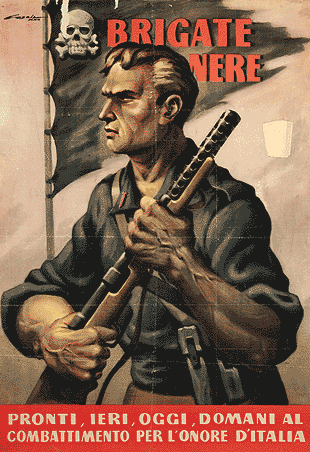

Visual Examples of Nationalism in Fascist Propaganda:



Visual Examples of Unity/Social Solidarity in Fascist Propaganda:

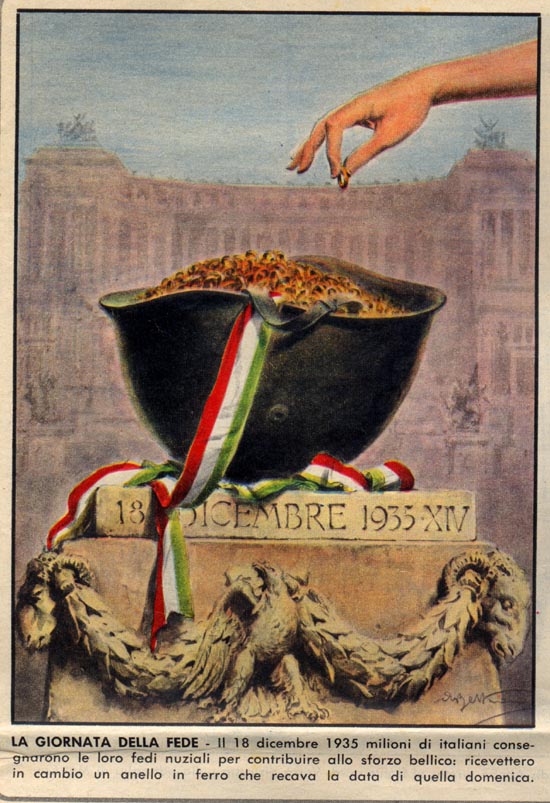

Visual Examples of Authoritarianism in Fascist Propaganda:
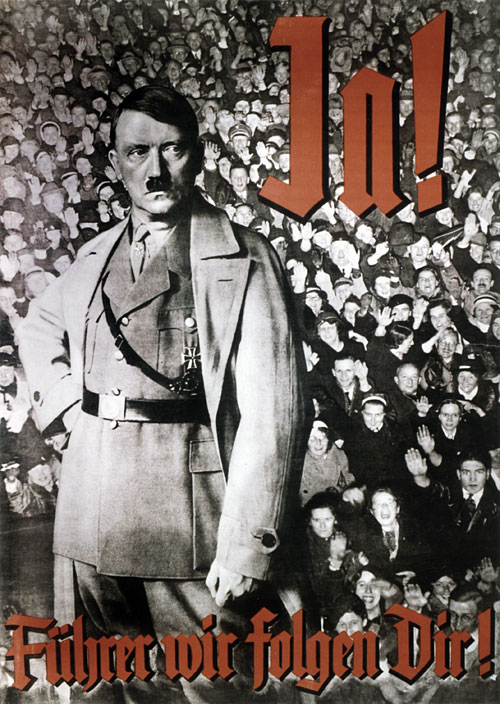

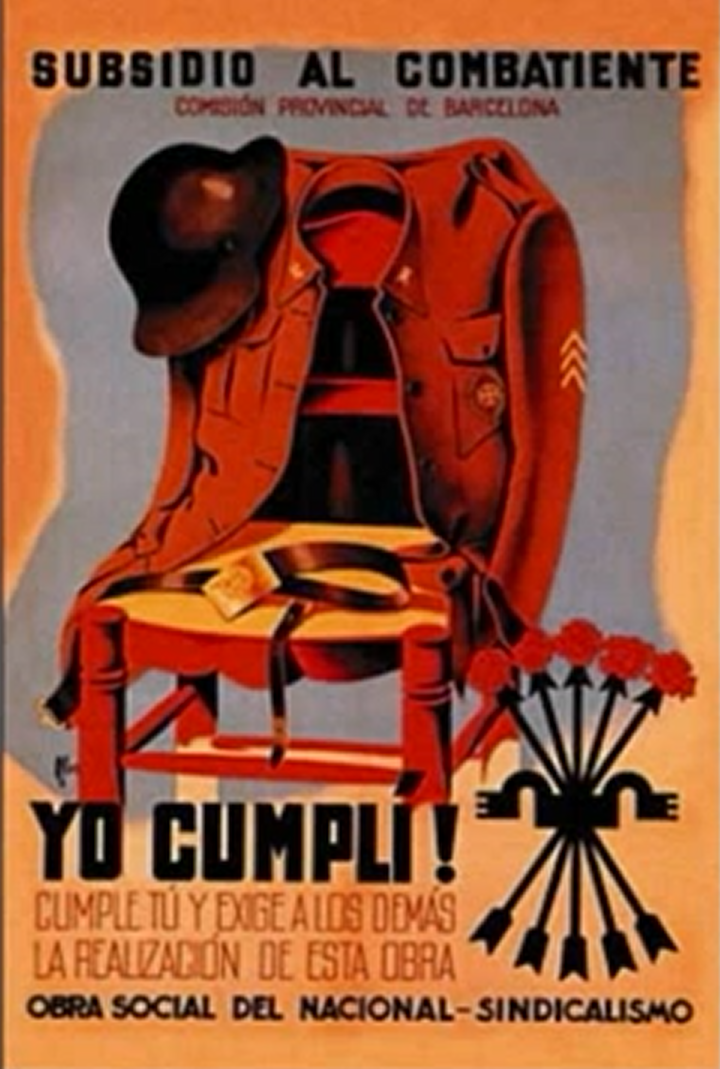
Visual Examples of Personality Cultism in Fascist Propaganda:
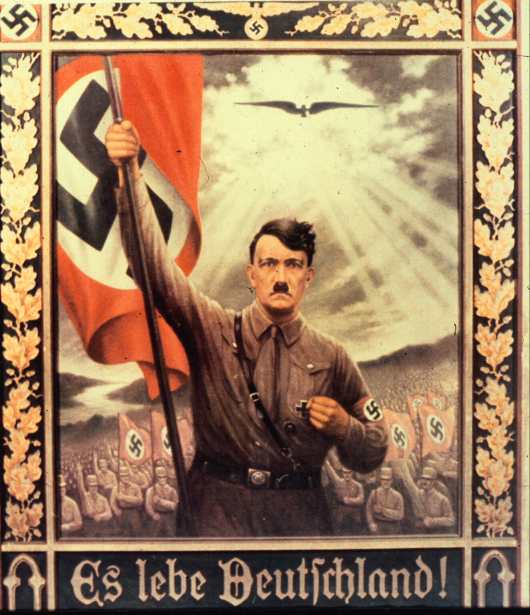


CLICK HERE TO VIEW A GALLERY OF FASCIST ART
CLICK HERE TO VIEW THE PAGE ON DEGENERATE ART
[1] Grčić, Joseph. Ethics and Political Theory (Lanham, Maryland: University of America, Inc, 2000) p. 120
[2] Oliver Zimmer, Nationalism in Europe, 1890–1940 (London, Palgrave, 2003), chapter 4, pp. 80–107.
[3] Mussolini, Benito. 1935. Fascism: Doctrine and Institutions. Rome: Ardita Publishers. p 14.
[4] Cult of personality. Encyclopædia Britannica. Retrieved June 25, 2009.
[5] “Spanish Civil War from 1936 to 1939.” Don Quijote. Web. 07 Feb. 2012. < http://www.donquijote.org/culture/spain/history/civilwar.asp >.
[6] The Truth About Spain!: Mobilizing British Public Opinion 1936-1939. p. 31
[7] Bendersky, Joseph W. A history of Nazi Germany: 1919-1945. 2nd ed. Burnham Publishers, 2000. p. 24.
[8] Simone Gigliotti, Berel Lang. The Holocaust: a reader. Malden, Massachusetts, USA; Oxford, England, UK; Carlton, Victoria, Australia: Blackwell Publishing, 2005. Pp. 14.
[9] http://www.holocaust-education.dk/baggrund/nazismensideologi.asp
[10] Mein Kampf citations are from the Project Gutenberg-hosted 1939 English translation by James Murphy
[11] Stout, Michael J., “The effectiveness of Nazi Propaganda During World War II”, 2011. Masters Theses and Doctoral Dissertations. < http://commons.emich.edu/theses/314>.
[12] “Mussolini and Fascism in Italy”. FSmitha.com. 8 January 2008.
[13] “Benito Amilcare Andrea Mussolini.” Jewish Virtual Library. American-Israeli Cooperative Enterprise. Web. 07 Feb. 2012. < http://www.jewishvirtuallibrary.org/jsource/biography/Mussolini.html >.
[14] “Mussolinis Italy.” IBHistoryHLWiki. 24 May 2007. Web. 7 Feb. 2012. <http://ibhistoryhlwiki.wikispaces.com/Mussolinis+Italy>.
